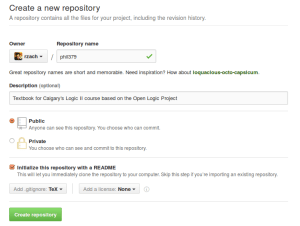I’ll be teaching the University of Calgary’s second logic course, imaginatively titled “Logic II,” next term. It’ll be the first time for me to use the Open Logic Text for this course. I used it for McGill’s “Intermediate Logic” earlier this year, and Nicole Wyatt has been using parts of the text the last time she taught it a year ago. Lots has changed, and I’m aiming to provide a nice, self-contained book. I’ll document the steps to make this happen.
To start, I have to pick the material to include. Logic II is supposed to cover “Introduction to the metatheory of logical systems. Completeness, compactness, Löwenheim-Skolem, and undecidability theorems for first-order logic.” In previous iterations, I’ve used Boolos, Burgess, and Jeffrey’s Computability and Logic as a textbook, and that’s also what my colleagues who also teach it have used. In part because of this, I’ve previously covered set theory, then Turing machines, first-order logic, undecidability, completeness and Löwenheim-Skolem theorems in that order: it’s the order BBJ covers it. But with an open text, I can rearrange things if I want to. And I think I do. Once you cover relations, it’s sort of natural to continue with first-order semantics, definability, and expressibility. So I’ll go with set theory, metatheory of first-order logic, Turing machines, and undecidability. (Right?)
To make a new book, you have to start by setting up a driver file that does all the setup and loads the parts and chapters you want in the right order. Of course, I’ll use Git also for that driver file and anything else I’ll need to pull things together. So,
Step 1: set up a GitHub repository [You can skip this step if you don’t want to use Git to keep track of changes.].

Step 2: Clone the repository, so I have it on my local drive. The Git URL is git@github.com:rzach/phil379.git. I use SSH, but there’s also an HTTS URL: https://github.com/rzach/phil379.git. Where do you put it? It’s probably easiest if it lives with the other courses in the OLP directory. So I go to where my OLP clone lives, then to the subdirectory holding the courses, and clone there:
$ cd ~/tex/openlogic/courses/
$ git clone git@github.com:rzach/phil379.git
$ cd phil379
[If you don’t want to use git, just make a new subdirectory of the /courses directory.]
Step 3: We have to start somewhere, so I’ll copy the files courses/sample/open-logic-sample.tex and courses/sample/open-logic-sample-config.tex from courses/sample to my new directory, renaming them to phil379.tex and phil379-config.tex, respectively. I’ll also add a license and a Makefile, but you wouldn’t have to.
Step 4: The main file, phil379.tex contains the instructions for what to include and in what order. I’ve changed it so that only what I need is included. Here is what it looks like at this point, and here are the changes I made to the original open-logic-sample.tex file. I haven’t yet done anything to the formatting or layout, just changed the title page and what chapters are included.
Step 5: I do want to do a few things a bit different from the default. First of all, I’ll make the text unpretentious: no Greek formulas, no Fraktur letters for structures. I haven’t yet made up my mind about terminology, but I think I might want to use “countable” instead of “enumerable”. (I wouldn’t if I were going to talk about “computably” or “recursively enumerable” sets, but I think I won’t. And when you’re talking about sizes of sets, “countable” and “uncountable” is a bit more conventional and easier to say. Maybe. I might change my mind later.) There are some switches I can adjust, too: e.g., I’d like to have everything but biconditional and “true” be primitive symbols: That way there are more cases to prove, but I’ll get all the cases for the conditional and the universal quantifier as exercises. Lastly, the first-order-logic part includes both sequent calculus and natural deduction as proof systems, but I’ll cover only one. Maybe natural deduction. Might change my mind on that too. Anyway, all these things can easily be specified in phil379-config.sty.
Step 6: Run phil379.tex through LaTeX, get a nice PDF.
Step 7: Commit everything and push to GitHub, so it’s saved (and I can link to the source files here).
[UPDATE: (a) The current version has phil379.tex containing only the content, and the layout and setup is done by phil379-screen.tex and phil379-print.tex, which generate a version for on-screen reading and a version for printing, respectively. See also this post.]

Richard Zach
[…] I started making my textbook for Logic II next term, in 7 easy steps. Read about it at the Open Logic Project. […]